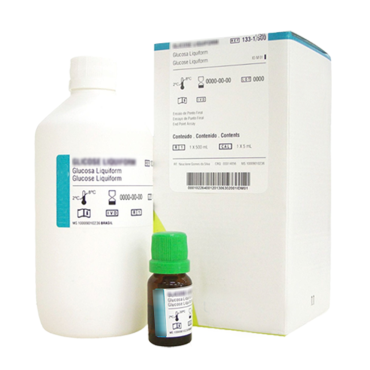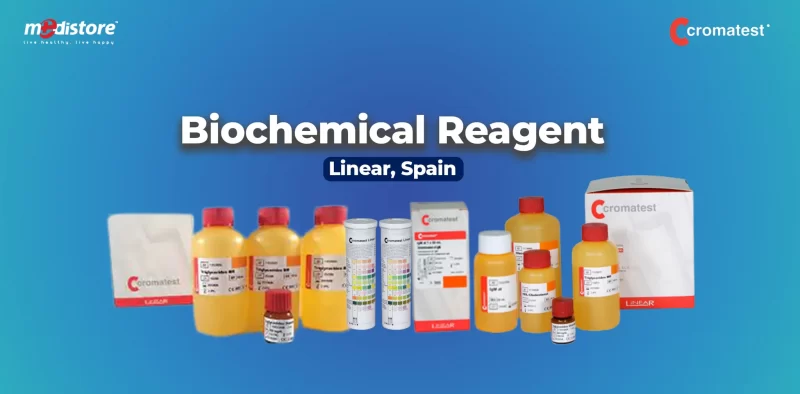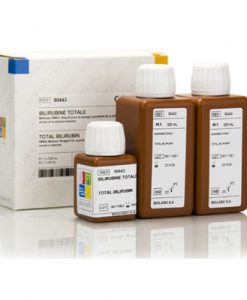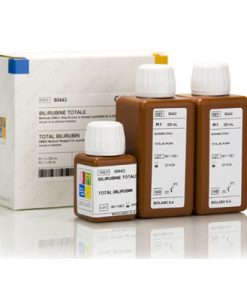Cromatest Protein (Urine And CSF) Biochemistry Reagent
৳ 2,110৳ 2,500 (-16%)
In stock
Cromatest (Urine And CSF) Protein Biochemistry Reagent
Packaging Size: 2x50 ml
Origin: Spain
Brand : Cromatest / Linear
Packaging Type: Bottle
Test/Pack: 100 Test
Method: colorimetric method
Frequently Bought Together
-
Add to Package (৳ 2,110
৳ 2,500(-16%)) -
Add to Package (৳ 2,200
৳ 2,500) -
Total Price: ৳ 4,310
- This item: Cromatest Protein (Urine And CSF) Biochemistry Reagent (৳ 2,110
৳ 2,500(-16%)) - Labkit Bilirubin Total Biochemistry Reagent - 250 Test(৳ 2,200
৳ 2,500)
Cromatest Protein (Urine & CSF) Biochemistry Reagent
PRINCIPLE
The method1 measures the shift in the absorption spectrum from 460 to 600 nm of the complex that occurs at acid pH between pyrogallol red-multidate (PRM) and the basic amino groups of urine and cerebrospinal fluid (CSF) proteins. The intensity of the colored complex formed is proportional to the concentration of protein in the sample.
REFERENCE VALUES3
Urine
Adults:
24-h samples : < 150 mg/ 24-h single samples: < 25 mg/dL
CSF:
Adults: < 45 mg/dL
Child:< 100 mg/dL
It is recommended that each laboratory establishes its own reference range
Best Quality Diagnostic Products Buy from Medistore

REAGENT COMPOSITION:
Pyrogallol reagent:
. Succinate buffer 60 mmol/L pH 2.5, pyrogallol red 0.06 mmol/L, sodium molibdate 0.04 mmol/L, SDS 0.08 mmol/L. Xn. R20/22 S:24/25.
Urine protein standard: Albumin/Globulin 200 mg/dL (2 g/L). Buffered mixture (80/20) on an artificial matrix. Biocides
STORAGE AND STABILITY:
Store R1 at 15-30ºC, and CAL at 2-8ºC once opened.
The reagents are stable until the expiry date stated on the label.
REAGENT PREPARATION
The reagents are ready-to-use.
SAMPLES
Urine collected without preservatives, and CSF (see Notes). Turbid specimens should be centrifuged before testing.
Urine proteins are stable up to 8 days at 2-8ºC, and for 3 months at –20ºC. CSF proteins are stable for 3 days at 2-8ºC and for 3 months at –20ºC
Buy Hematology Analyzer Reagent at best price from Medistore
QUALITY CONTROL
The use of a standard to calculate results allows to obtain an accuracy independent of the system or instrument used.
To ensure adequate quality control (QC), each run should include a set of urine controls (normal and abnormal) with assayed values handled as unknowns.
CLINICAL SIGNIFICANCE
Total protein in the urine measurement is increasingly being replaced by the measurement of albumin, as this is the predominant urinary protein as this have demonstrated improved sensitivity and specificity for glomerular permeability changes.
The presence of increased urinary excretion signals an increase in the transpupillary escape rate, being usually a marker of microvascular disease even though it may be also altered by physiological factors (exercise, diuresis and posture) as a consequence of altered intrarenal hemodynamics.
The tubular reabsortive process is saturable and any increase in the glomerular permeability or in plasma concentration (e.g., of Bence-Jones protein), or decreases in reabsortive capacity due to proximal tubular damage (e.g., from nephrotoxic drugs) can result in proteinuria.
Persistent urinary albumin excretion precedes and is highly predictive of diabetic nephropathy, end-stage renal disease, and proliferative retinopathy in type I diabetes.5
Measurement of CSF protein is used to distinguish septic from aseptic meningitis. Protein concentrations > 1 g/L are often viewed as diagnostic for bacterial, fungal, or tuberculous meningitis.6
NOTES
- Currently samples acceptable are : 24-h collection; overnight (8-12-h) collection; 1-2-h collection, or first morning sample. Because the high interindividual and diurnal variation, at least three separate samples should be
- To increase the sensitivity in the normal range test 50 mL of sample, and dilute the standard 1:4 (1+3) with saline. Use the new concentration of 50 mg/dL for the
ANALYTICAL PERFORMANCE
- Linearity: Up Up to 400 mg/dL (4 g/L)L
- Precision
| mg/dL | Within-run | Between-run | ||
| Mean | 64 | 180 | 65 | 175 |
| SD | 4.2 | 9.7 | 4.7 | 9.8 |
| CV% | 6.5 | 5.4 | 7.2 | 5.6 |
| N | 5 | 5 | 3 | 3 |
Replicates: 5 for each level. Replicates: 3 for each level Instrument: CECIL CE 2021 for 4 days.
- Sensitivity. Using a 1:50 sample/reagent at 600 nm, 1 mg of protein will produce a net absorbance of approximately 003.
- Correlation. This assay (y) was compared with a similar commercial method (x). The results were:
N = 30 r = 0.996 y = 1.194 – 3.76
INTERFERENCES
-
-
-
- Positive interferences in urine of patients under treatment with aminoglycosids-gentamicine or tobromycine-reported with other pyrogallol tests have been shown to have no influence with this specific 2
- Specimens collected after exertion, in the presence of urinary tract infection, during acute illness or immediately after surgery are not suitable for testing giving false results.
- CSF contaminated by red cells from a traumatic lumbar puncture or intracerebral hemorrhage will increase protein
concentrations by » 10 mg/L for every 1000 erithrocytes.3
-
-
MATERIALS REQUIRED
- Photometer or colorimeter capable of measuring absorbance at 600 ± 20 nm.
- Constant temperature incubator set at 37ºC.
PROCEDURE
- Bring reagents and samples to room
- Pipette into labelled tubes:
-
TUBES
Blank
Sample
Standard
Reagent 1.0 mL 1.0 mL 1.0 mL Sample Standard – –
20 mL –
– 20 mL
- Mix and incubate the tubes 5 minutes at 37ºC or 10 minutes at room
- Read the absorbance (A) of the samples and the standard at 600 nm against the reagent blank.
- The color is stable for 30 minutes protected from light
CALCULATIONS
Samples with concentrations higher than 400 mg/dL should be diluted 1:2 with saline and assayed again. Multiply the results by 2.
REFERENCES
- Orsonneau, L., Dovet, P., Massoubre, C., Lustenberger, P., and Bernard, S. Clin. Chem. 35: 2233 (1989).
- Koerbin, , Taylor, L., Dutton, J., Marshall, K, Low, P., and Potter, J.M. Clin. Chem. 47: 2183 (2001).
- Greenlee, E. Infect. Dis. Clin. North Am. 4: 583 (1990).
- N.W. Clinical Guide to Laboratory Tests, 3rd Edition. W.B. Saunders Co. Philadelphia, PA. (1995).
- Viberti, C., Hill, R.D., and Jarret, R.J. Lancet, I : 1430 (1982).
Brand
Chromatest
Linear
You must be logged in to post a review.









Reviews
There are no reviews yet.